Digital Twins in Critical Infrastructure
Abstract
:1. Introduction
2. Digital Twins
3. Materials and Methods
4. Result Analysis
4.1. Descriptive Information
4.2. Citation Analysis
4.3. Source Analysis
4.4. Affiliation Analysis
4.5. Country Analysis
4.6. Document Analysis
5. Discussion
6. Conclusions
Author Contributions
Funding
Informed Consent Statement
Data Availability Statement
Conflicts of Interest
References
- Esnoul, C.; Colomo-Palacios, R.; Jee, E.; Chockalingam, S.; Eidar Simensen, J.; Bae, D.-H. Report on the 3rd international workshop on engineering and cybersecurity of critical systems (EnCyCriS-2022). ACM SIGSOFT Softw. Eng. Notes 2023, 48, 81–84. [Google Scholar] [CrossRef]
- Ouyang, M. Review on modeling and simulation of interdependent critical infrastructure systems. Reliab. Eng. Syst. Saf. 2014, 121, 43–60. [Google Scholar] [CrossRef]
- Alcaraz, C.; Zeadally, S. Critical infrastructure protection: Requirements and challenges for the 21st century. Int. J. Crit. Infrastruct. Prot. 2015, 8, 53–66. [Google Scholar] [CrossRef]
- Rathnayaka, B.; Siriwardana, C.; Robert, D.; Amaratunga, D.; Setunge, S. Improving the resilience of critical infrastructures: Evidence-based insights from a systematic literature review. Int. J. Disaster Risk Reduct. 2022, 78, 103123. [Google Scholar] [CrossRef]
- Khan Babar, A.H.; Ali, Y. Framework construction for augmentation of resilience in critical infrastructure: Developing countries a case in point. Technol. Soc. 2022, 68, 101809. [Google Scholar] [CrossRef]
- Wells, E.M.; Boden, M.; Tseytlin, I.; Linkov, I. Modeling critical infrastructure resilience under compounding threats: A systematic literature review. Prog. Disaster Sci. 2022, 15, 100244. [Google Scholar] [CrossRef]
- Chowdhury, N.; Gkioulos, V. Cyber security training for critical infrastructure protection: A literature review. Comput. Sci. Rev. 2021, 40, 100361. [Google Scholar] [CrossRef]
- Ani, U.P.D.; He, H.; Tiwari, A. Review of cybersecurity issues in industrial critical infrastructure: Manufacturing in perspective. J. Cyber Secur. Technol. 2017, 1, 32–74. [Google Scholar] [CrossRef]
- Pokhrel, A.; Katta, V.; Colomo-Palacios, R. Digital twin for cybersecurity incident prediction. In Proceedings of the IEEE/ACM 42nd International Conference on Software Engineering Workshops, New York, NY, USA, 25 September 2020. [Google Scholar] [CrossRef]
- Ghorbani, A.A.; Bagheri, E. The state of the art in critical infrastructure protection: A framework for convergence. Int. J. Crit. Infrastruct. 2008, 4, 215–244. [Google Scholar] [CrossRef]
- Rinaldi, S.M.; Peerenboom, J.P.; Kelly, T.K. Identifying, understanding, and analyzing critical infrastructure interdependencies. IEEE Control Syst. 2001, 21, 11–25. [Google Scholar] [CrossRef]
- Brown, G.; Carlyle, M.; Salmerón, J.; Wood, K. Defending critical infrastructure. Interfaces 2006, 36, 530–544. [Google Scholar] [CrossRef]
- Aradau, C. Security that matters: Critical infrastructure and objects of protection. Secur. Dialogue 2010, 41, 491–514. [Google Scholar] [CrossRef]
- USA National Infrastructure Advisory Council (NIAC). Critical Infrastructure Resilience: Final Report and Recommendations; National Infrastructure Advisory Council: Arlington, VA, USA, 2009.
- Rehak, D.; Senovsky, P.; Hromada, M.; Lovecek, T. Complex approach to assessing resilience of critical infrastructure elements. Int. J. Crit. Infrastruct. Prot. 2019, 25, 125–138. [Google Scholar] [CrossRef]
- Cybersecurity & Infrastructure–Security Agency (CISA). Critical Infrastructure Sectors; Cybersecurity & Infrastructure–Security Agency (CISA): Washington, DC, USA, 2023.
- Moteff, J.D.; Parfomak, P.; Resources, Science, and Industry Division. Critical Infrastructure and Key Assets: Definition and Identification; Congressional Research Service, Library of Congress: Washington, DC, USA, 2004.
- Zimmerman, R. Social implications of infrastructure network interactions. J. Urban Technol. 2001, 8, 97–119. [Google Scholar] [CrossRef]
- Dudenhoeffer, D.; Permann, M.; Manic, M. CIMS: A framework for infrastructure interdependency modeling and analysis. In Proceedings of the 2006 winter simulation conference, Monterey, CA, USA; 2006. [Google Scholar] [CrossRef]
- Wallace, W.A.; Mendonca, D.; Lee, E.; Mitchell, J.E.; Chow, J. Managing disruptions to critical interdependent infrastructures in the context of the 2001 world trade center attack. Beyond Sept. 11th Acc. Post-Disaster Res. 2003, 42, 165–198. [Google Scholar]
- Lee II, E.E.; Mitchell, J.E.; Wallace, W.A. Restoration of services in interdependent infrastructure systems: A network flows approach. IEEE Trans. Syst. Man Cybern. Part C (Appl. Rev.) 2007, 37, 1303–1317. [Google Scholar] [CrossRef]
- Zhang, P.; Peeta, S. A generalized modeling framework to analyze interdependencies among infrastructure systems. Transp. Res. Part B Methodol. 2011, 45, 553–579. [Google Scholar] [CrossRef]
- Lampropoulos, G.; Siakas, K. Enhancing and securing cyber-physical systems and industry 4.0 through digital twins: A critical review. J. Softw. Evol. Process 2022, 35, e2494. [Google Scholar] [CrossRef]
- Jiang, Y.; Yin, S.; Li, K.; Luo, H.; Kaynak, O. Industrial applications of digital twins. Philos. Trans. R. Soc. A Math. Phys. Eng. Sci. 2021, 379, 20200360. [Google Scholar] [CrossRef]
- Tao, F.; Qi, Q. Make more digital twins. Nature 2019, 573, 490–491. [Google Scholar] [CrossRef]
- Batty, M. Digital twins. Environ. Plan. B Urban Anal. City Sci. 2018, 45, 817–820. [Google Scholar] [CrossRef]
- Stark, R.; Fresemann, C.; Lindow, K. Development and operation of digital twins for technical systems and services. CIRP Ann. 2019, 68, 129–132. [Google Scholar] [CrossRef]
- Sharma, A.; Kosasih, E.; Zhang, J.; Brintrup, A.; Calinescu, A. Digital twins: State of the art theory and practice, challenges, and open research questions. J. Ind. Inf. Integr. 2022, 30, 100383. [Google Scholar] [CrossRef]
- El Saddik, A. Digital twins: The convergence of multimedia technologies. IEEE MultiMedia 2018, 25, 87–92. [Google Scholar] [CrossRef]
- Lampropoulos, G. Artificial intelligence, big data, and machine learning in industry 4.0. In Encyclopedia of Data Science and Machine Learning; IGI Global: Hershey, PA, USA, 2023; pp. 2101–2109. [Google Scholar] [CrossRef]
- Piras, G.; Agostinelli, S.; Muzi, F. Digital Twin Framework for Built Environment: A Review of Key Enablers. Energies 2024, 17, 436. [Google Scholar] [CrossRef]
- Liu, C.; Zhang, P.; Xu, X. Literature Review of Digital Twin Technologies for Civil Infrastructure. J. Infrastruct. Intell. Resil. 2023, 2, 100050. [Google Scholar] [CrossRef]
- Broo, D.G.; Schooling, J. Digital Twins in Infrastructure: Definitions, Current Practices, Challenges and Strategies. Int. J. Constr. Manag. 2021, 23, 1254–1263. [Google Scholar] [CrossRef]
- Cheng, R.; Hou, L.; Xu, S. A Review of Digital Twin Applications in Civil and Infrastructure Emergency Management. Buildings 2023, 13, 1143. [Google Scholar] [CrossRef]
- Astarita, V.; Guido, G.; Haghshenas, S.S.; Haghshenas, S.S. Risk Reduction in Transportation Systems: The Role of Digital Twins According to a Bibliometric-Based Literature Review. Sustainability 2024, 16, 3212. [Google Scholar] [CrossRef]
- Kajba, M.; Jereb, B.; Cvahte Ojsteršek, T. Exploring Digital Twins in the Transport and Energy Fields: A Bibliometrics and Literature Review Approach. Energies 2023, 16, 3922. [Google Scholar] [CrossRef]
- Taherkhani, R.; Ashtari, M.A.; Aziminezhad, M. Digital Twin-Enabled Infrastructures: A Bibliometric Analysis-Based Review. J. Infrastruct. Syst. 2024, 30, 03123001. [Google Scholar] [CrossRef]
- Ciano, M.P.; Pozzi, R.; Rossi, T.; Strozzi, F. Digital twin-enabled smart industrial systems: A bibliometric review. Int. J. Comput. Integr. Manuf. 2021, 34, 690–708. [Google Scholar] [CrossRef]
- Moiceanu, G.; Paraschiv, G. Digital Twin and Smart Manufacturing in Industries: A Bibliometric Analysis with a Focus on Industry 4.0. Sensors 2022, 22, 1388. [Google Scholar] [CrossRef] [PubMed]
- Ghansah, F.A.; Lu, W. Major opportunities of digital twins for smart buildings: A scientometric and content analysis. Smart Sustain. Built Environ. 2024, 13, 63–84. [Google Scholar] [CrossRef]
- Katsoulakis, E.; Wang, Q.; Wu, H.; Shahriyari, L.; Fletcher, R.; Liu, J.; Achenie, L.; Liu, H.; Jackson, P.; Xiao, Y.; et al. Digital twins for health: A scoping review. NPJ Digit. Med. 2024, 7, 77. [Google Scholar] [CrossRef] [PubMed]
- Wu, J.; Wang, X.; Dang, Y.; Lv, Z. Digital twins and artificial intelligence in transportation infrastructure: Classification, application, and future research directions. Comput. Electr. Eng. 2022, 101, 107983. [Google Scholar] [CrossRef]
- Kouroupis, K.; Sotiropoulos, L. Cyber Challenges amid the Digital Revolution in Maritime Transport. Jurid. Trib.-Rev. Comp. Int. Law 2024, 14, 321–340. [Google Scholar] [CrossRef]
- Heluany, J.B.; Gkioulos, V. A review on digital twins for power generation and distribution. Int. J. Inf. Secur. 2024, 23, 1171–1195. [Google Scholar] [CrossRef]
- Palensky, P.; Cvetkovic, M.; Gusain, D.; Joseph, A. Digital twins and their use in future power systems. Digit. Twin 2022, 1, 4. [Google Scholar] [CrossRef]
- Rosen, R.; Fischer, J.; Boschert, S. Next generation digital twin: An ecosystem for mechatronic systems? IFAC-PapersOnline 2019, 52, 265–270. [Google Scholar] [CrossRef]
- Liljaniemi, A.; Paavilainen, H. Using Digital Twin Technology in Engineering Education–Course Concept to Explore Benefits and Barriers. Open Eng. 2020, 10, 377–385. [Google Scholar] [CrossRef]
- Schleich, B.; Anwer, N.; Mathieu, L.; Wartzack, S. Shaping the digital twin for design and production engineering. CIRP Ann. 2017, 66, 141–144. [Google Scholar] [CrossRef]
- Bécue, A.; Maia, E.; Feeken, L.; Borchers, P.; Praça, I. A New Concept of Digital Twin Supporting Optimization and Resilience of Factories of the Future. Appl. Sci. 2020, 10, 4482. [Google Scholar] [CrossRef]
- Jacoby, M.; Usländer, T. Digital Twin and Internet of Things—Current Standards Landscape. Appl. Sci. 2020, 10, 6519. [Google Scholar] [CrossRef]
- Söderberg, R.; Wärmefjord, K.; Carlson, J.S.; Lindkvist, L. Toward a digital twin for real-time geometry assurance in individualized production. CIRP Ann. 2017, 66, 137–140. [Google Scholar] [CrossRef]
- Fuller, A.; Fan, Z.; Day, C.; Barlow, C. Digital Twin: Enabling Technologies, Challenges and Open Research. IEEE Access 2020, 8, 108952–108971. [Google Scholar] [CrossRef]
- Ashtari Talkhestani, B.; Weyrich, M. Digital Twin of manufacturing systems: A case study on increasing the efficiency of reconfiguration. at-Automatisierungstechnik 2020, 68, 435–444. [Google Scholar] [CrossRef]
- Liu, M.; Fang, S.; Dong, H.; Xu, C. Review of digital twin about concepts, technologies, and industrial applications. J. Manuf. Syst. 2020, 58, 346–361. [Google Scholar] [CrossRef]
- Eckhart, M.; Ekelhart, A. Digital Twins for Cyber-Physical Systems Security: State of the Art and Outlook. In Security and Quality in Cyber-Physical Systems Engineering; Springer International Publishing: New York, NY, USA, 2019; pp. 383–412. [Google Scholar] [CrossRef]
- Grieves, M.; Vickers, J. Digital twin: Mitigating unpredictable, undesirable emergent behavior in complex systems. In Transdisciplinary Perspectives on Complex Systems; Springer: New York, NY, USA, 2017; pp. 85–113. [Google Scholar] [CrossRef]
- Boschert, S.; Rosen, R. Digital twin—The simulation aspect. In Mechatronic Futures; Springer: New York, NY, USA, 2016; pp. 59–74. [Google Scholar] [CrossRef]
- Schluse, M.; Rossmann, J. From simulation to experimentable digital twins: Simulation-based development and operation of complex technical systems. In Proceedings of the 2016 IEEE International Symposium on Systems Engineering (ISSE), Edinburgh, UK, 3–5 October 2016; pp. 1–6. [Google Scholar] [CrossRef]
- Židek, K.; Piteľ, J.; Adámek, M.; Lazorík, P.; Hošovský, A. Digital Twin of Experimental Smart Manufacturing Assembly System for Industry 4.0 Concept. Sustainability 2020, 12, 3658. [Google Scholar] [CrossRef]
- Zhang, H.; Liu, Q.; Chen, X.; Zhang, D.; Leng, J. A digital twin-based approach for designing and multi-objective optimization of hollow glass production line. IEEE Access 2017, 5, 26901–26911. [Google Scholar] [CrossRef]
- Zheng, Y.; Yang, S.; Cheng, H. An application framework of digital twin and its case study. J. Ambient. Intell. Humaniz. Comput. 2019, 10, 1141–1153. [Google Scholar] [CrossRef]
- Chen, Y. Integrated and intelligent manufacturing: Perspectives and enablers. Engineering 2017, 3, 588–595. [Google Scholar] [CrossRef]
- Haag, S.; Anderl, R. Digital twin–proof of concept. Manuf. Lett. 2018, 15, 64–66. [Google Scholar] [CrossRef]
- Schluse, M.; Priggemeyer, M.; Atorf, L.; Rossmann, J. Experimentable digital twins—Streamlining simulation-based systems engineering for industry 4.0. IEEE Trans. Ind. Inform. 2018, 14, 1722–1731. [Google Scholar] [CrossRef]
- VrabiČ, R.; Erkoyuncu, J.A.; Butala, P.; Roy, R. Digital twins: Understanding the added value of integrated models for through-life engineering services. Procedia Manuf. 2018, 16, 139–146. [Google Scholar] [CrossRef]
- Talkhestani, B.A.; Jung, T.; Lindemann, B.; Sahlab, N.; Jazdi, N.; Schloegl, W.; Weyrich, M. An architecture of an intelligent digital twin in a cyber-physical production system. at-Automatisierungstechnik 2019, 67, 762–782. [Google Scholar] [CrossRef]
- Malakuti, S.; Schalkwyk, O.V.; Boss, B.; Ram Sastry, C.; Runkana, V.; Lin, S.; Rix, S.; Green, G.; Baechle, K.; Varan Nath, C. Digital twins for industrial applications. Definition, Business Values, Design Aspects, Standards and Use Cases. Ind. Internet Consort. White Pap. 2020, 1, 1–19. [Google Scholar]
- Kritzinger, W.; Karner, M.; Traar, G.; Henjes, J.; Sihn, W. Digital twin in manufacturing: A categorical literature review and classification. IFAC-PapersOnLine 2018, 51, 1016–1022. [Google Scholar] [CrossRef]
- Malakuti, S.; Grüner, S. Architectural aspects of digital twins in IIoT systems. In Proceedings of the 12th European Conference on Software Architecture: Companion Proceedings, New York, NY, USA, 24–28 September 2018; pp. 1–2. [Google Scholar] [CrossRef]
- Grieves, M. Digital twin: Manufacturing excellence through virtual factory replication. White Pap. 2014, 1, 1–7. [Google Scholar]
- Vachálek, J.; Bartalskỳ, L.; Rovnỳ, O.; Šišmišová, D.; Morháč, M.; Lokšík, M. The digital twin of an industrial production line within the industry 4.0 concept. In Proceedings of the 2017 21st International Conference on Process Control (PC), Strbske Pleso, Slovakia, 6–9 June 2017; IEEE: New York, NY, USA, 2017; pp. 258–262. [Google Scholar] [CrossRef]
- Tao, F.; Cheng, J.; Qi, Q.; Zhang, M.; Zhang, H.; Sui, F. Digital twin-driven product design, manufacturing and service with big data. Int. J. Adv. Manuf. Technol. 2018, 94, 3563–3576. [Google Scholar] [CrossRef]
- Bao, J.; Guo, D.; Li, J.; Zhang, J. The modelling and operations for the digital twin in the context of manufacturing. Enterp. Inf. Syst. 2019, 13, 534–556. [Google Scholar] [CrossRef]
- Rasheed, A.; San, O.; Kvamsdal, T. Digital Twin: Values, Challenges and Enablers From a Modeling Perspective. IEEE Access 2020, 8, 21980–22012. [Google Scholar] [CrossRef]
- Shahzad, M.; Shafiq, M.T.; Douglas, D.; Kassem, M. Digital Twins in Built Environments: An Investigation of the Characteristics, Applications, and Challenges. Buildings 2022, 12, 120. [Google Scholar] [CrossRef]
- Datta, S.P.A. Emergence of digital twins. arXiv 2016, arXiv:1610.06467. [Google Scholar]
- Eckhart, M.; Ekelhart, A. Towards security-aware virtual environments for digital twins. In Proceedings of the 4th ACM Workshop on Cyber-Physical System Security, New York, NY, USA, 22 May 2018; pp. 61–72. [Google Scholar] [CrossRef]
- Ellegaard, O.; Wallin, J.A. The bibliometric analysis of scholarly production: How great is the impact? Scientometrics 2015, 105, 1809–1831. [Google Scholar] [CrossRef]
- Gusenbauer, M.; Haddaway, N.R. Which academic search systems are suitable for systematic reviews or meta-analyses? Evaluating retrieval qualities of google scholar, PubMed, and 26 other resources. Res. Synth. Methods 2020, 11, 181–217. [Google Scholar] [CrossRef]
- Donthu, N.; Kumar, S.; Mukherjee, D.; Pandey, N.; Lim, W.M. How to conduct a bibliometric analysis: An overview and guidelines. J. Bus. Res. 2021, 133, 285–296. [Google Scholar] [CrossRef]
- Aria, M.; Cuccurullo, C. Bibliometrix: An r-tool for comprehensive science mapping analysis. J. Informetr. 2017, 11, 959–975. [Google Scholar] [CrossRef]
- Mongeon, P.; Paul-Hus, A. The journal coverage of web of science and scopus: A comparative analysis. Scientometrics 2015, 106, 213–228. [Google Scholar] [CrossRef]
- Zhu, J.; Liu, W. A tale of two databases: The use of web of science and scopus in academic papers. Scientometrics 2020, 123, 321–335. [Google Scholar] [CrossRef]
- Page, M.J.; McKenzie, J.E.; Bossuyt, P.M.; Boutron, I.; Hoffmann, T.C.; Mulrow, C.D.; Shamseer, L.; Tetzlaff, J.M.; Akl, E.A.; Brennan, S.E.; et al. The PRISMA 2020 statement: An updated guideline for reporting systematic reviews. Int. J. Surg. 2021, 88, 105906. [Google Scholar] [CrossRef] [PubMed]
- Tao, F.; Zhang, H.; Liu, A.; Nee, A.Y.C. Digital Twin in Industry: State-of-the-Art. IEEE Trans. Ind. Inf. 2019, 15, 2405–2415. [Google Scholar] [CrossRef]
- Rosen, R.; Von Wichert, G.; Lo, G.; Bettenhausen, K.D. About the importance of autonomy and digital twins for the future of manufacturing. IFAC-PapersOnLine 2015, 48, 567–572. [Google Scholar] [CrossRef]
- Qi, Q.; Tao, F.; Zuo, Y.; Zhao, D. Digital Twin Service towards Smart Manufacturing. Procedia CIRP 2018, 72, 237–242. [Google Scholar] [CrossRef]
- Tao, F.; Zhang, M. Digital twin Shop-Floor: A new Shop-Floor paradigm towards smart manufacturing. IEEE Access 2017, 5, 20418–20427. [Google Scholar] [CrossRef]
- Lu, Y.; Liu, C.; Wang, K.I.-K.; Huang, H.; Xu, X. Digital twin-driven smart manufacturing: Connotation, reference model, applications and research issues. Robot. Comput. -Integr. Manuf. 2020, 61, 101837. [Google Scholar] [CrossRef]
- Uhlemann, T.H.-J.; Lehmann, C.; Steinhilper, R. The digital twin: Realizing the cyber-physical production system for industry 4.0. Procedia Cirp 2017, 61, 335–340. [Google Scholar] [CrossRef]
- Tao, F.; Qi, Q.; Wang, L.; Nee, A.Y.C. Digital Twins and Cyber–Physical Systems toward Smart Manufacturing and Industry 4.0: Correlation and Comparison. Engineering 2019, 5, 653–661. [Google Scholar] [CrossRef]
- Zhang, J.; Yu, Q.; Zheng, F.; Long, C.; Lu, Z.; Duan, Z. Comparing keywords plus of WOS and author keywords: A case study of patient adherence research. J. Assoc. Inf. Sci. Technol. 2016, 67, 967–972. [Google Scholar] [CrossRef]
- Barricelli, B.R.; Fogli, D. Digital twins in human-computer interaction: A systematic review. Int. J. Hum. –Comput. Interact. 2024, 40, 79–97. [Google Scholar] [CrossRef]
- Kaššaj, M.; Peráček, T. Synergies and Potential of Industry 4.0 and Automated Vehicles in Smart City Infrastructure. Appl. Sci. 2024, 14, 3575. [Google Scholar] [CrossRef]
- Attaran, S.; Attaran, M.; Celik, B.G. Digital Twins and Industrial Internet of Things: Uncovering operational intelligence in industry 4.0. Decis. Anal. J. 2024, 10, 100398. [Google Scholar] [CrossRef]
- Guo, J.; Bilal, M.; Qiu, Y.; Qian, C.; Xu, X.; Choo, K.K.R. Survey on digital twins for Internet of Vehicles: Fundamentals, challenges, and opportunities. Digit. Commun. Netw. 2024, 10, 237–247. [Google Scholar] [CrossRef]
- Tao, F.; Zhang, H.; Zhang, C. Advancements and challenges of digital twins in industry. Nat. Comput. Sci. 2024, 4, 169–177. [Google Scholar] [CrossRef] [PubMed]
- Negri, E.; Fumagalli, L.; Macchi, M. A review of the roles of digital twin in CPS-based production systems. Procedia Manuf. 2017, 11, 939–948. [Google Scholar] [CrossRef]
- Laplante, P.; Amaba, B. Artificial intelligence in critical infrastructure systems. Computer 2021, 54, 14–24. [Google Scholar] [CrossRef]
- Radanliev, P.; De Roure, D.; Nicolescu, R.; Huth, M.; Santos, O. Digital twins: Artificial intelligence and the IoT cyber-physical systems in industry 4.0. Int. J. Intell. Robot. Appl. 2022, 6, 171–185. [Google Scholar] [CrossRef]
- Rathore, M.M.; Shah, S.A.; Shukla, D.; Bentafat, E.; Bakiras, S. The role of AI, machine learning, and big data in digital twinning: A systematic literature review, challenges, and opportunities. IEEE Access 2021, 9, 32030–32052. [Google Scholar] [CrossRef]
- Lv, Z.; Xie, S. Artificial intelligence in the digital twins: State of the art, challenges, and future research topics. Digit. Twin 2022, 1, 12. [Google Scholar] [CrossRef]
- Bordukova, M.; Makarov, N.; Rodriguez-Esteban, R.; Schmich, F.; Menden, M.P. Generative artificial intelligence empowers digital twins in drug discovery and clinical trials. Expert Opin. Drug Discov. 2023, 19, 33–42. [Google Scholar] [CrossRef]
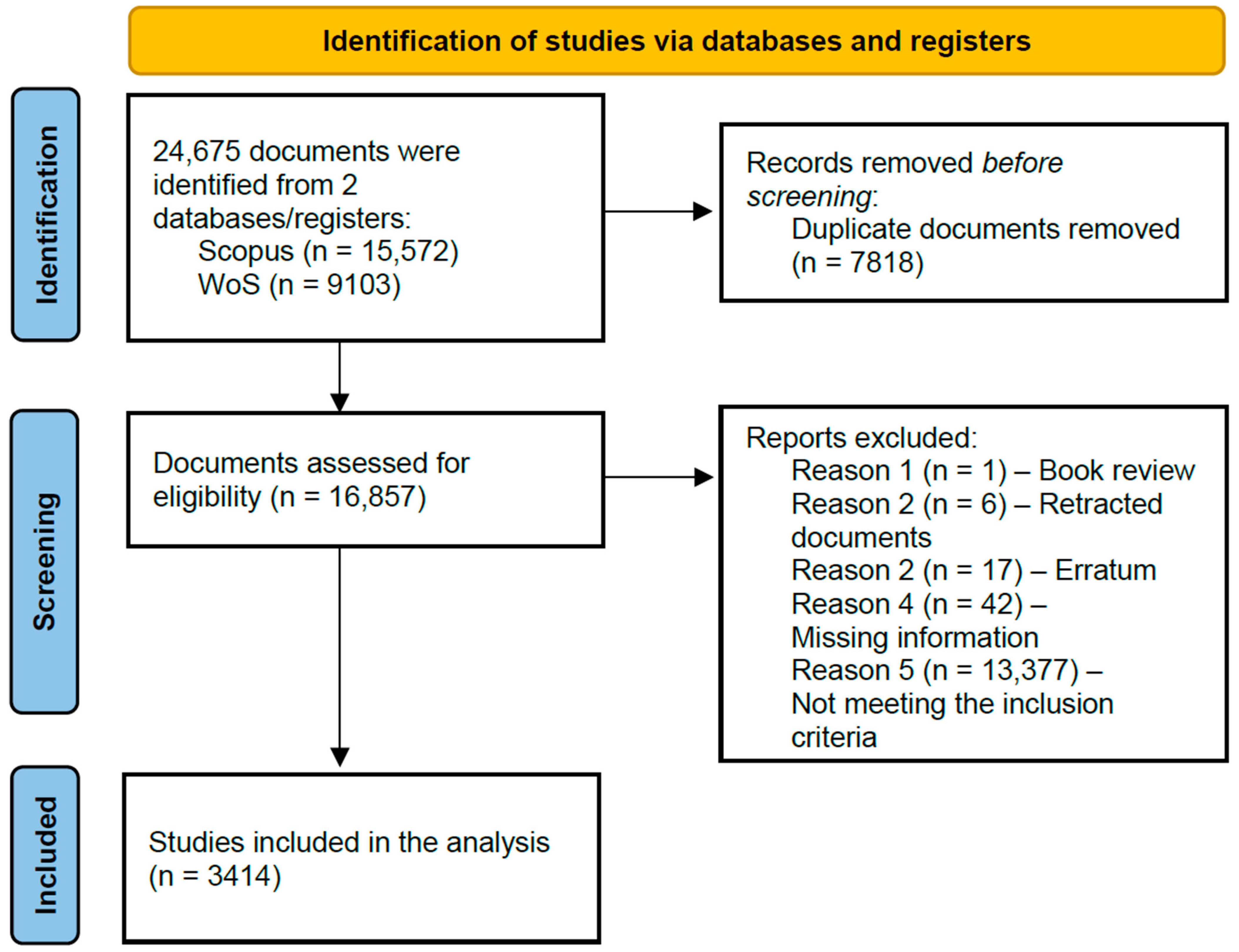

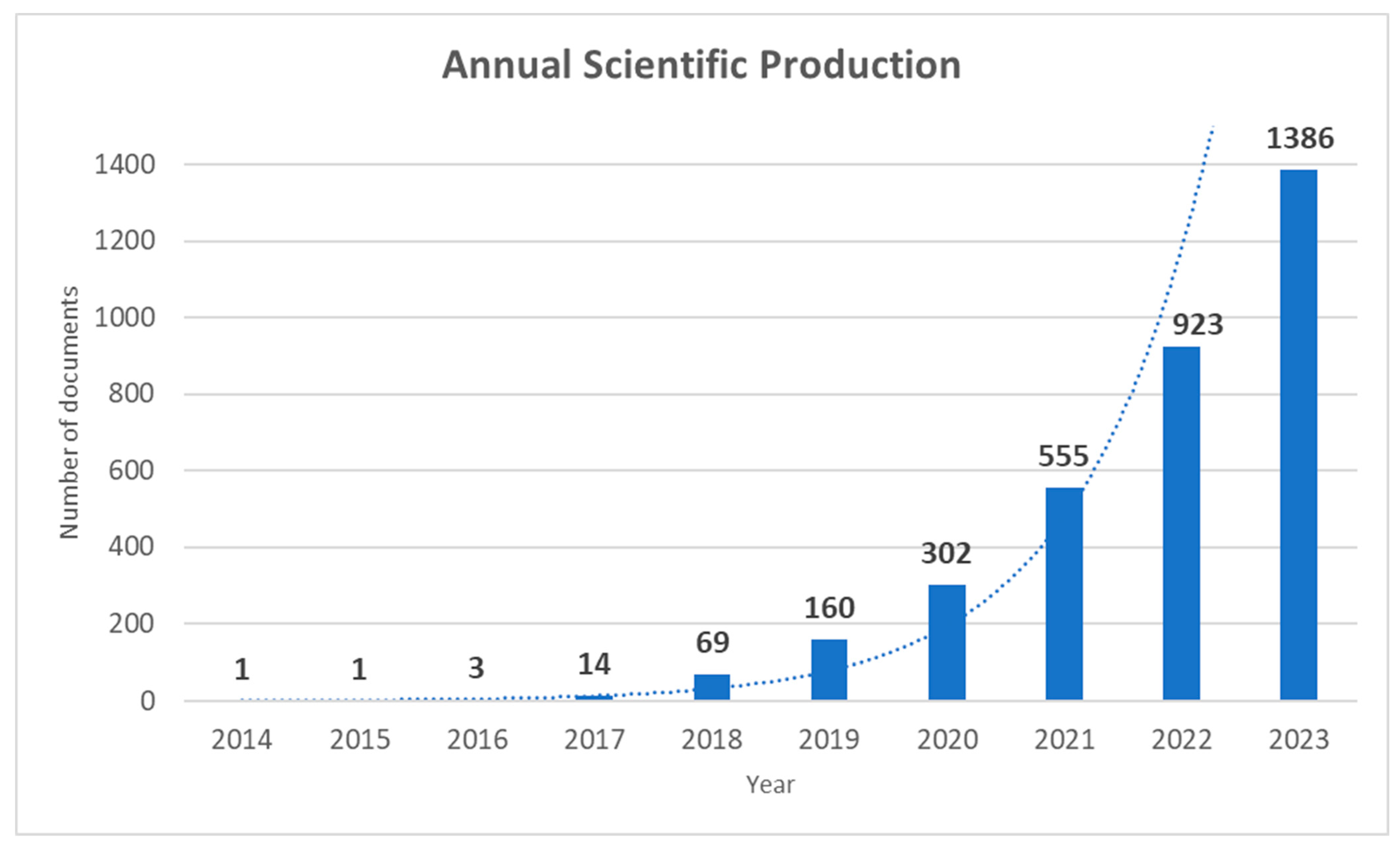


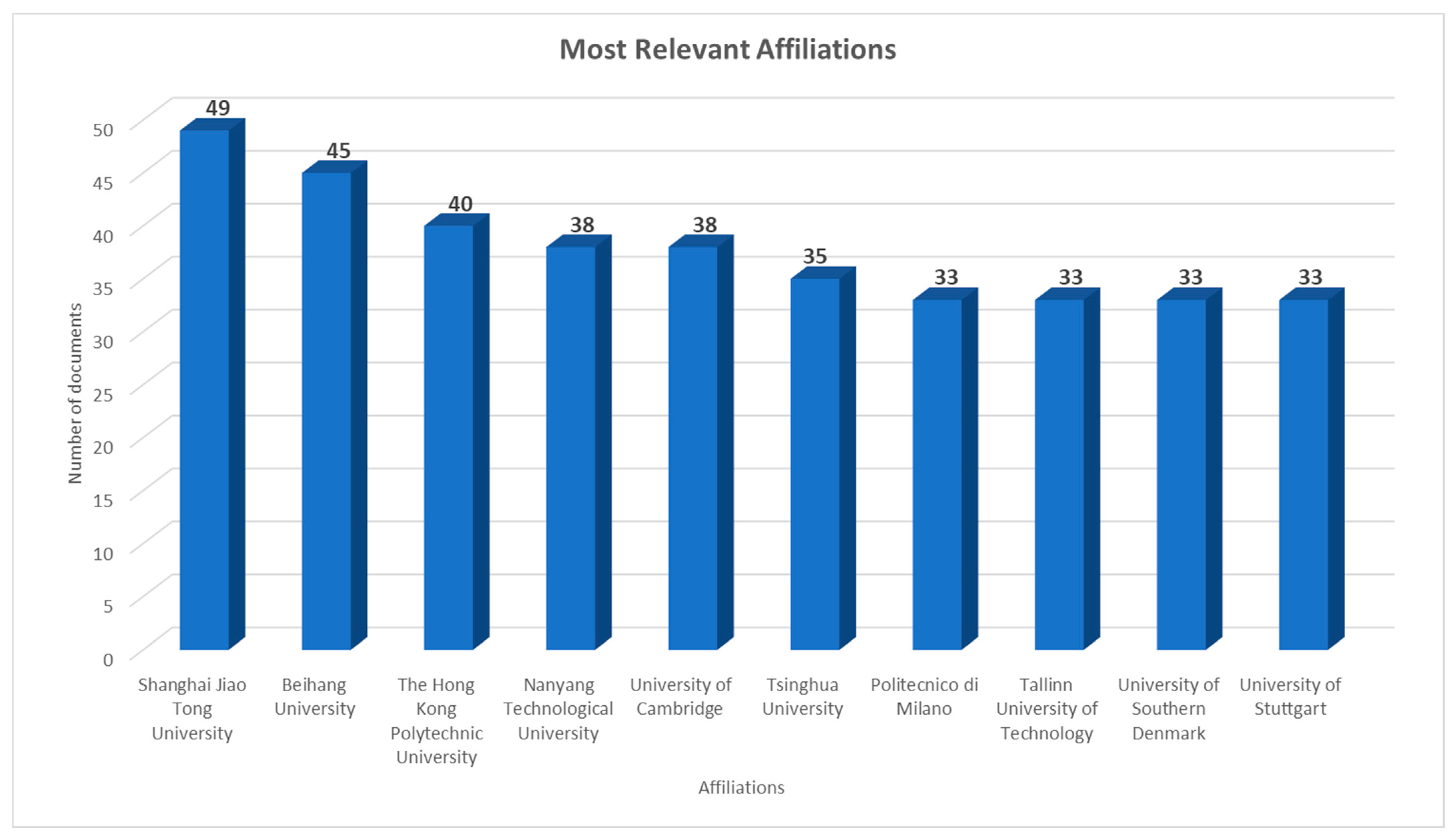
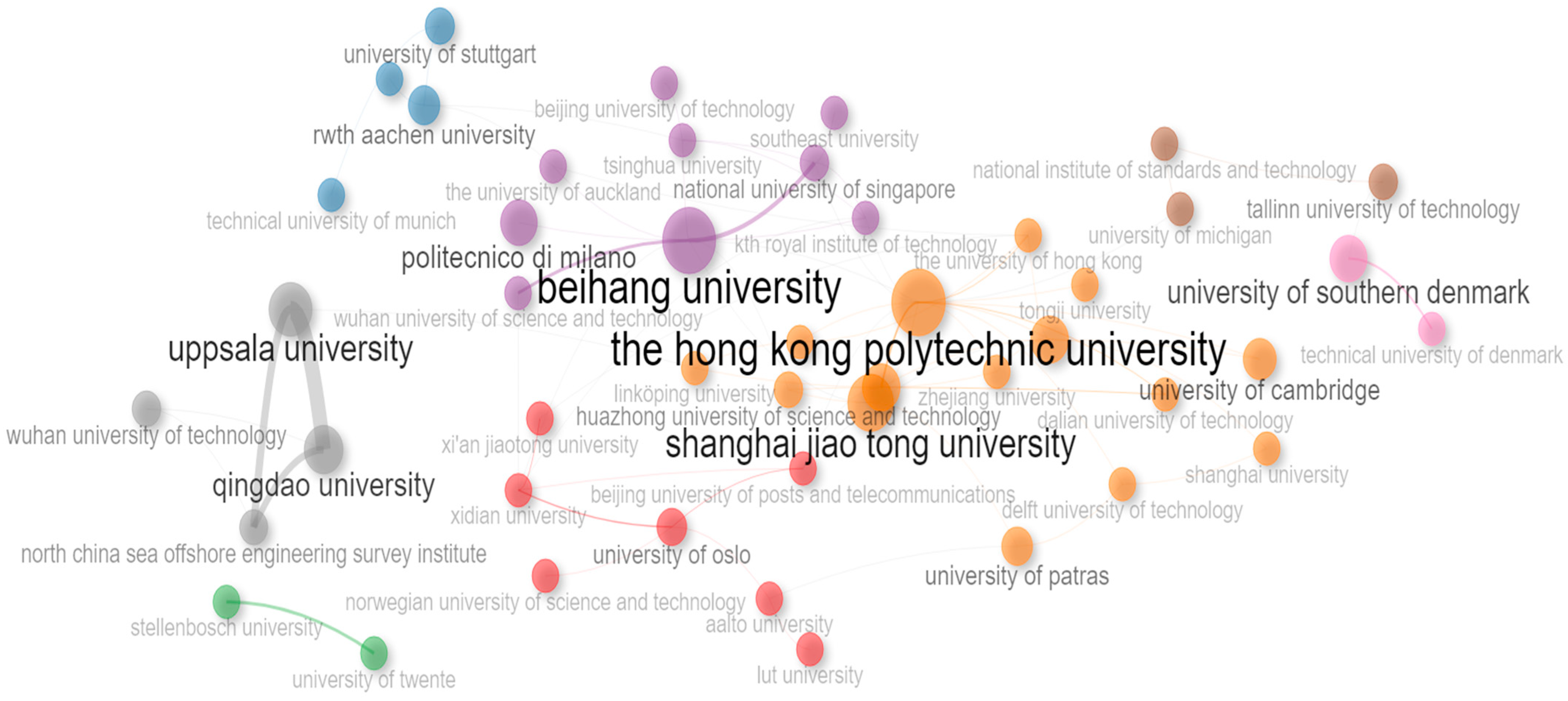

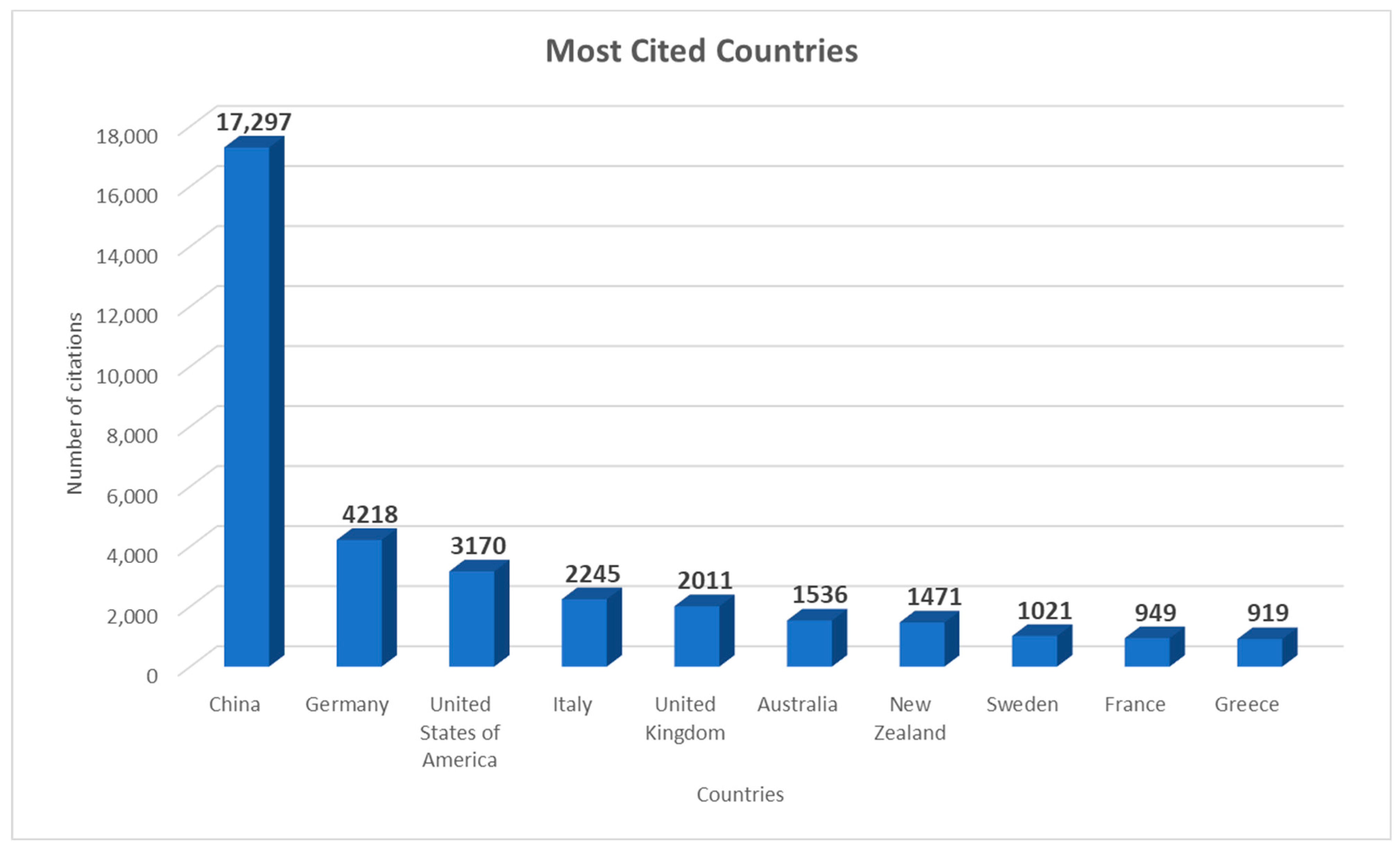
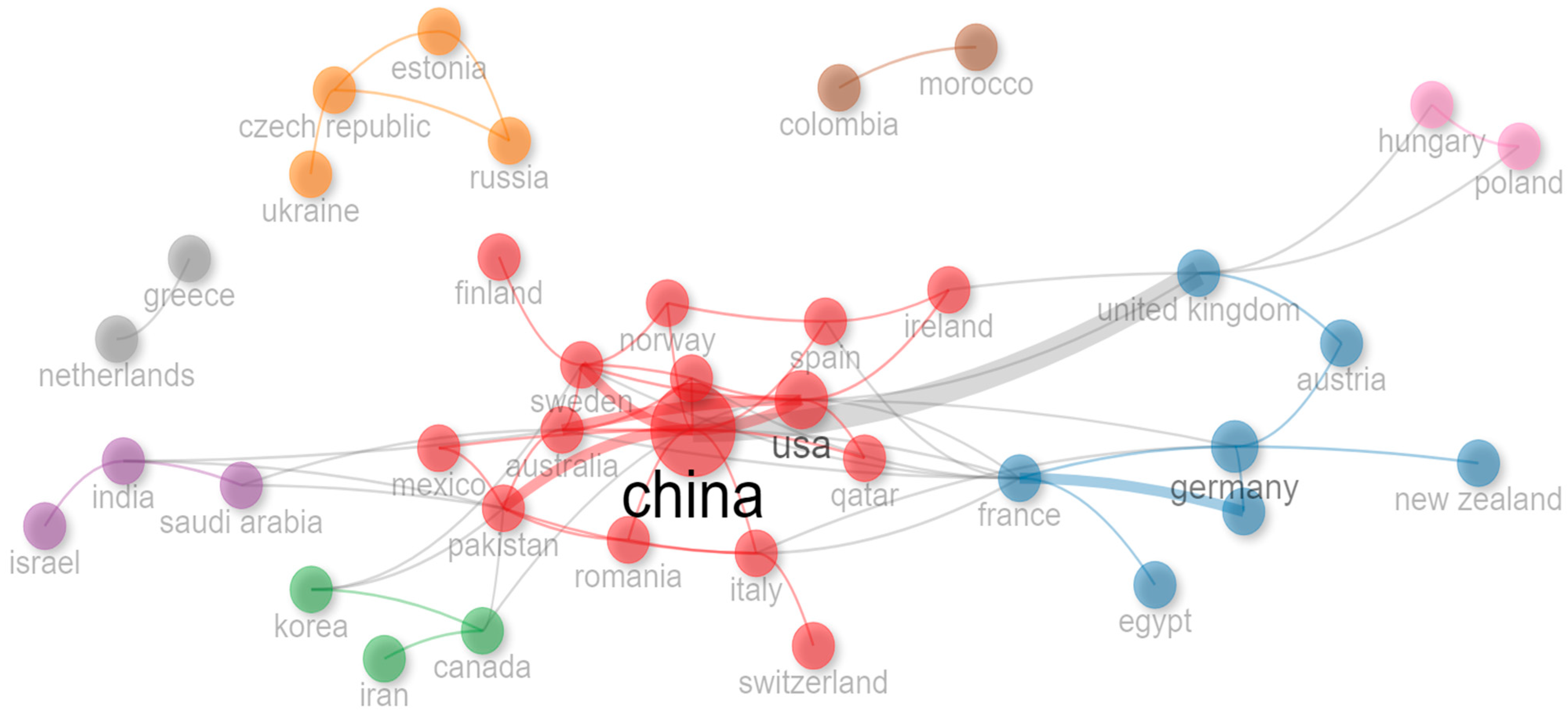
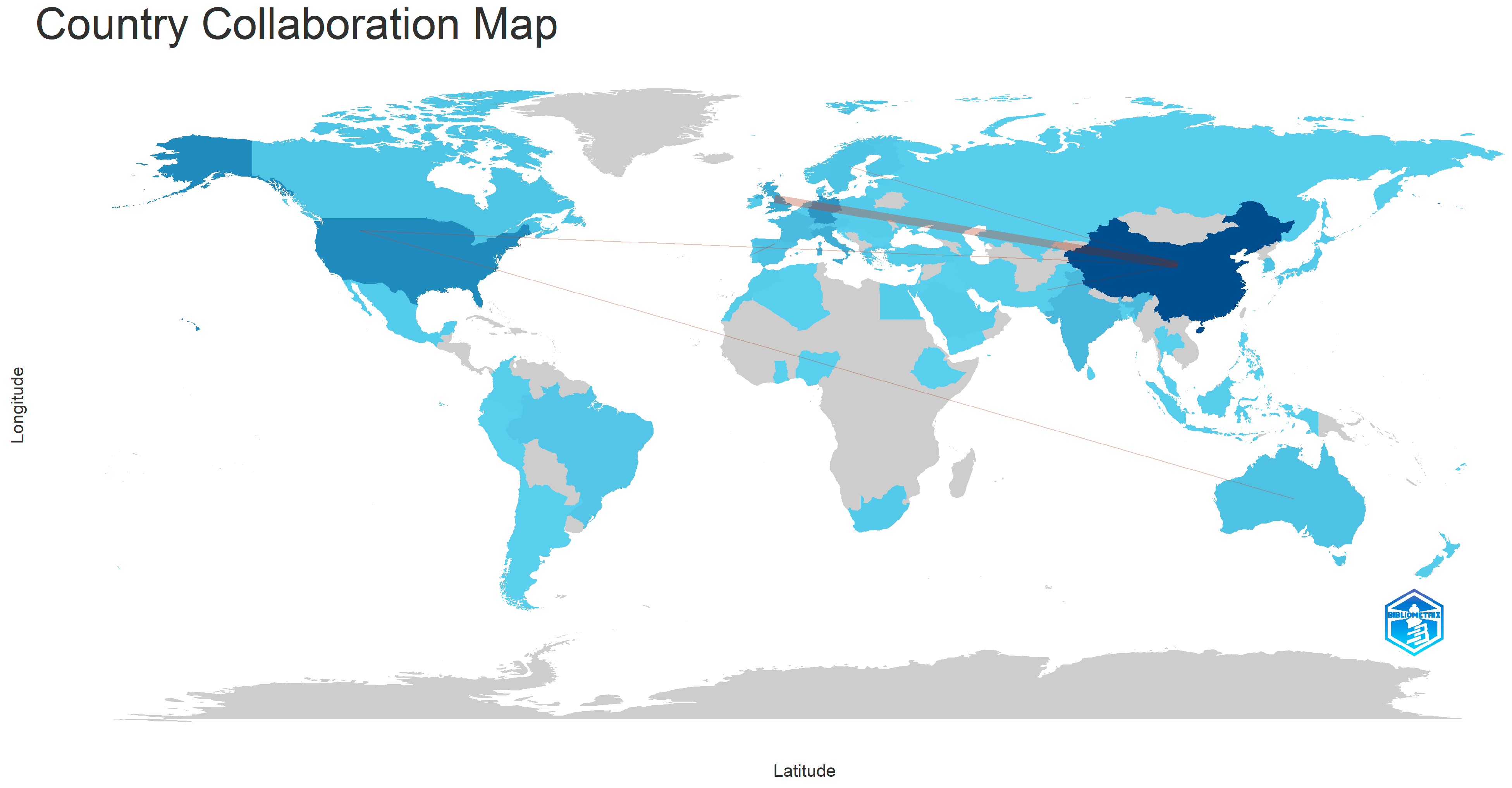
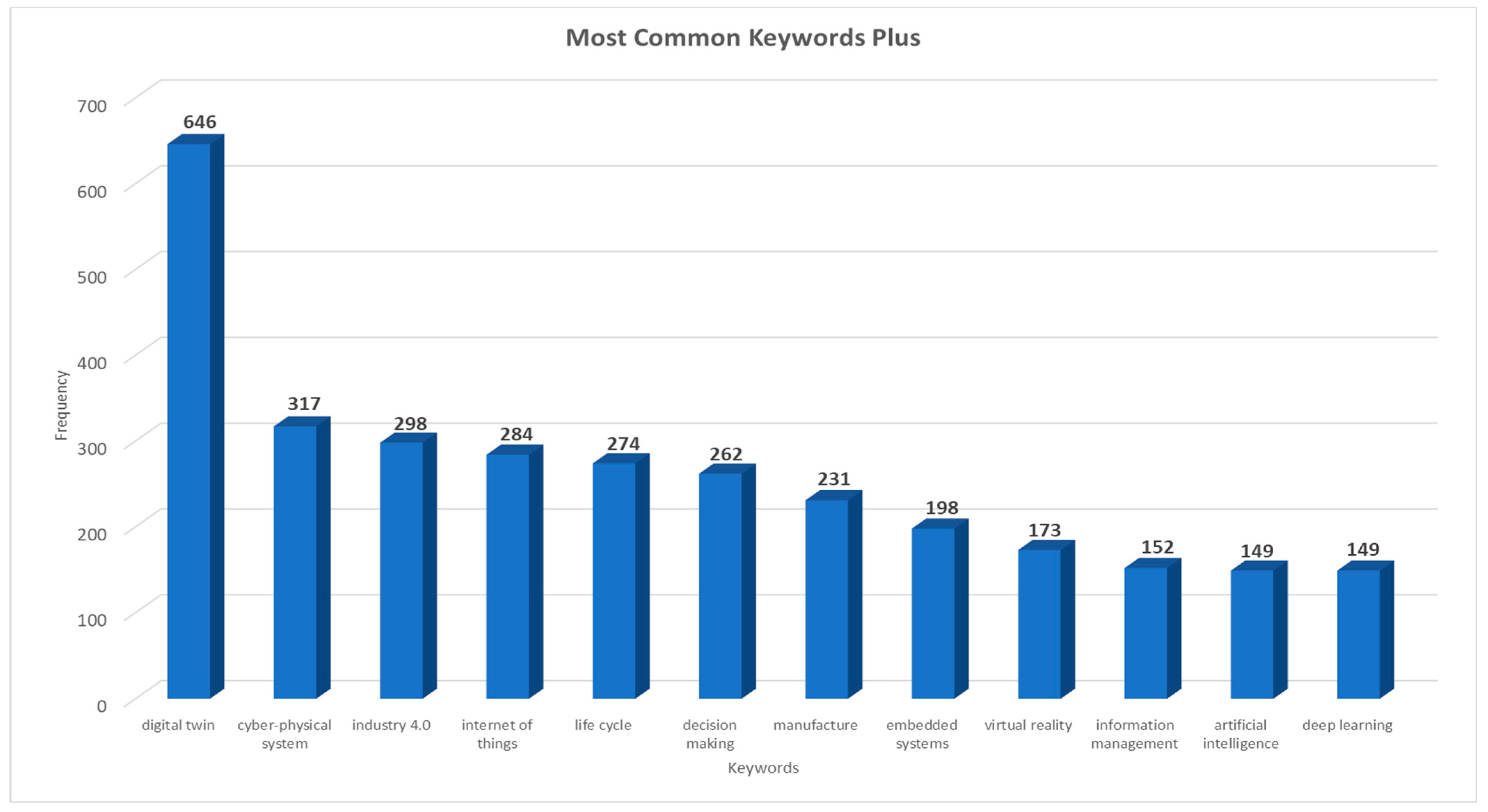
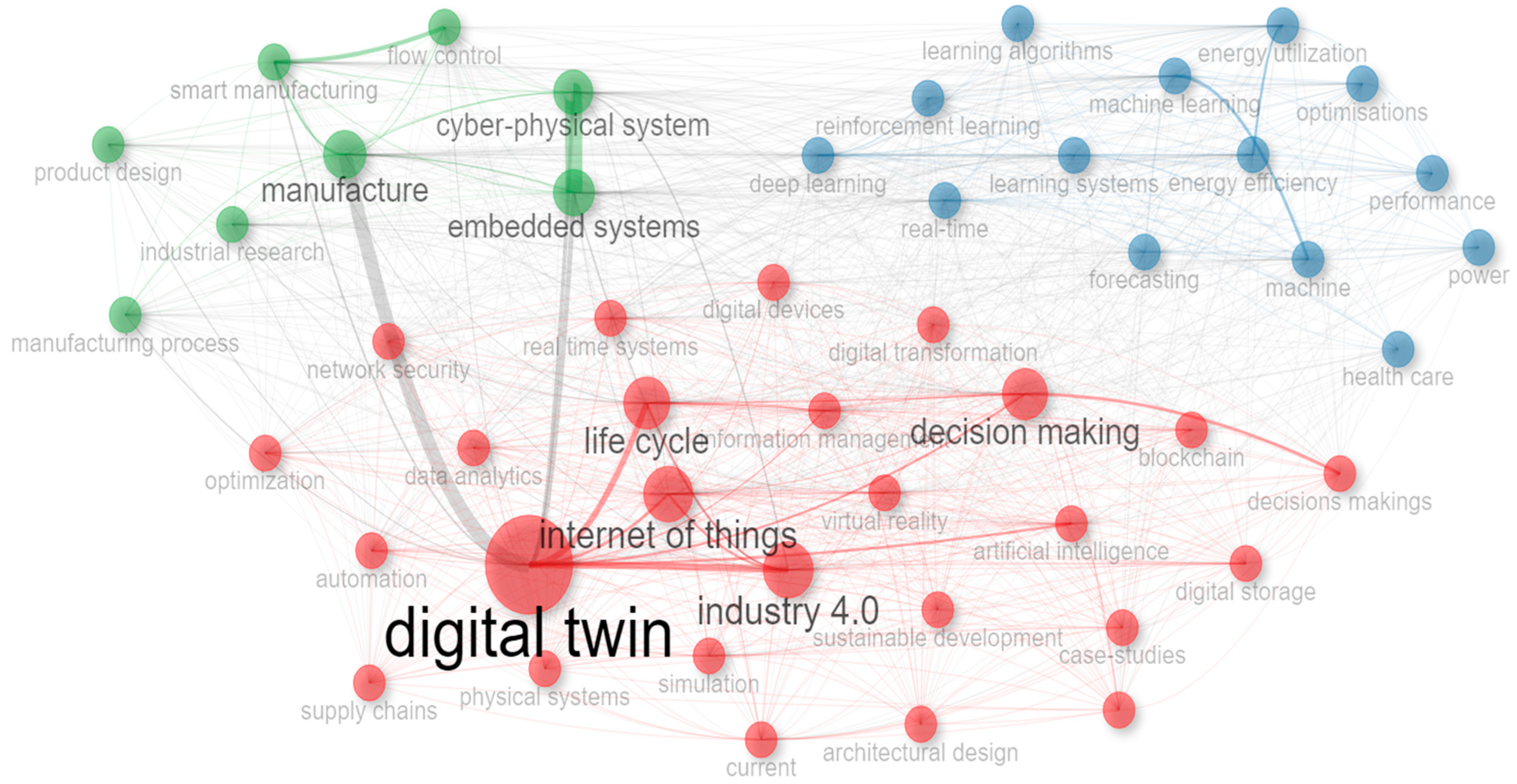
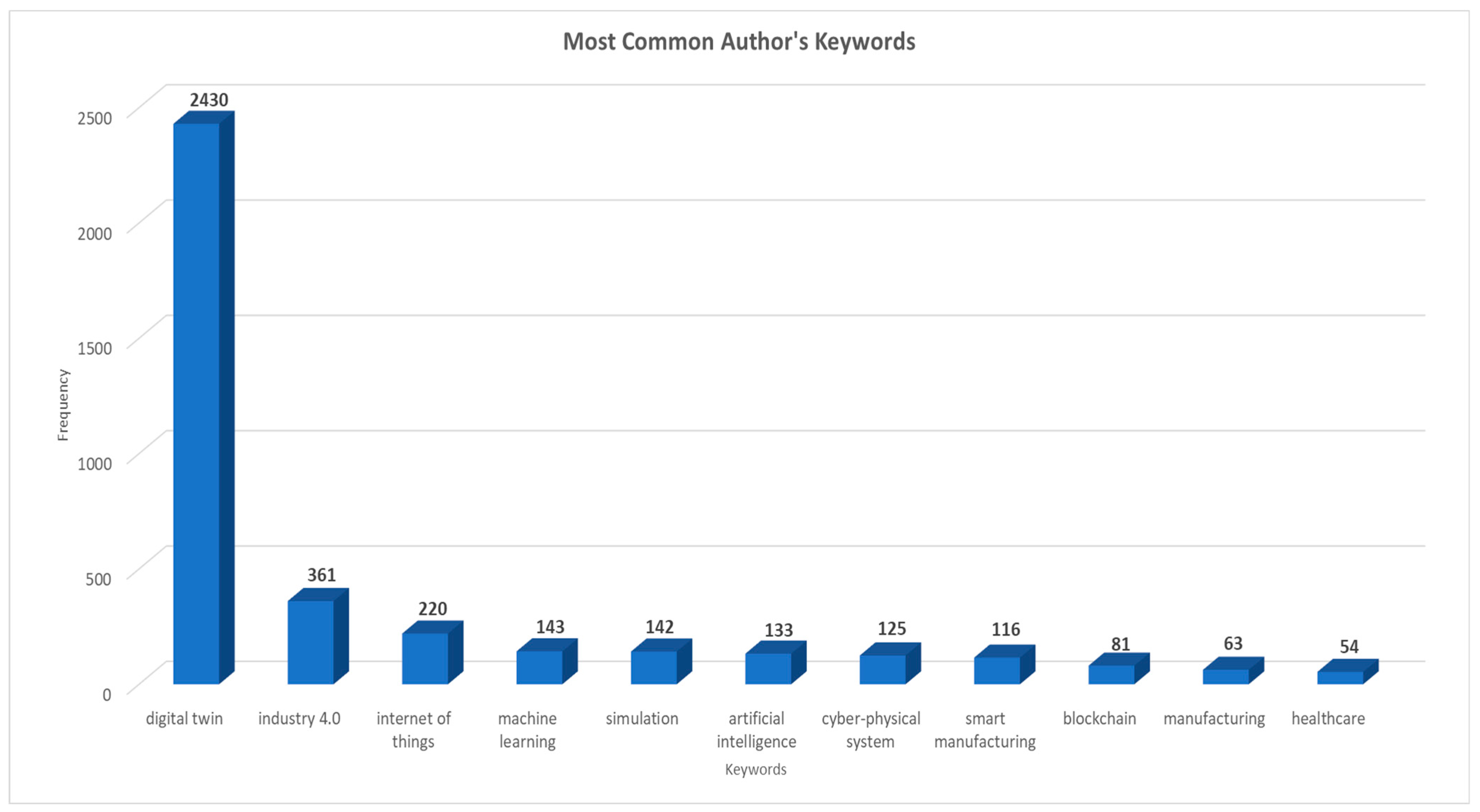
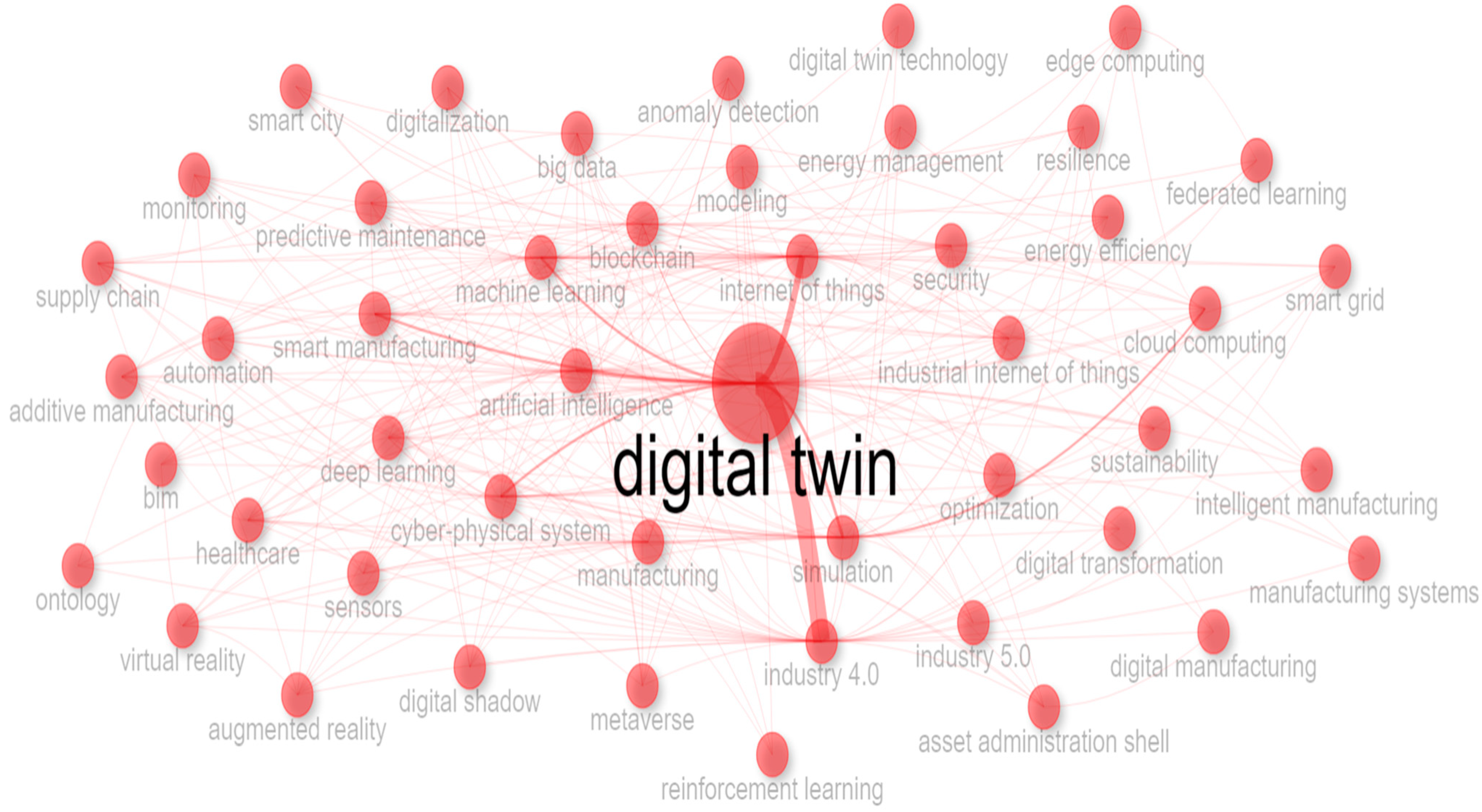
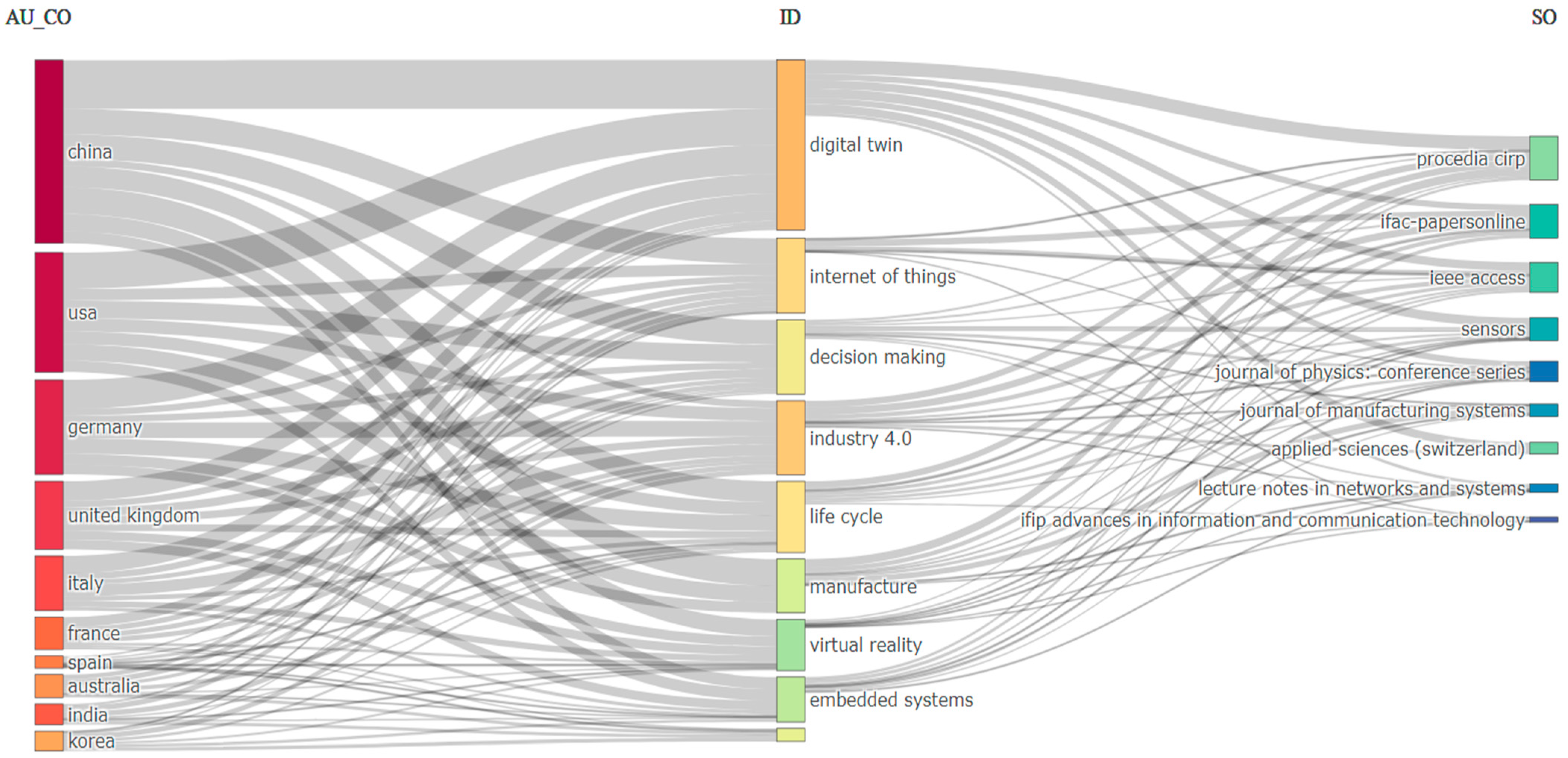

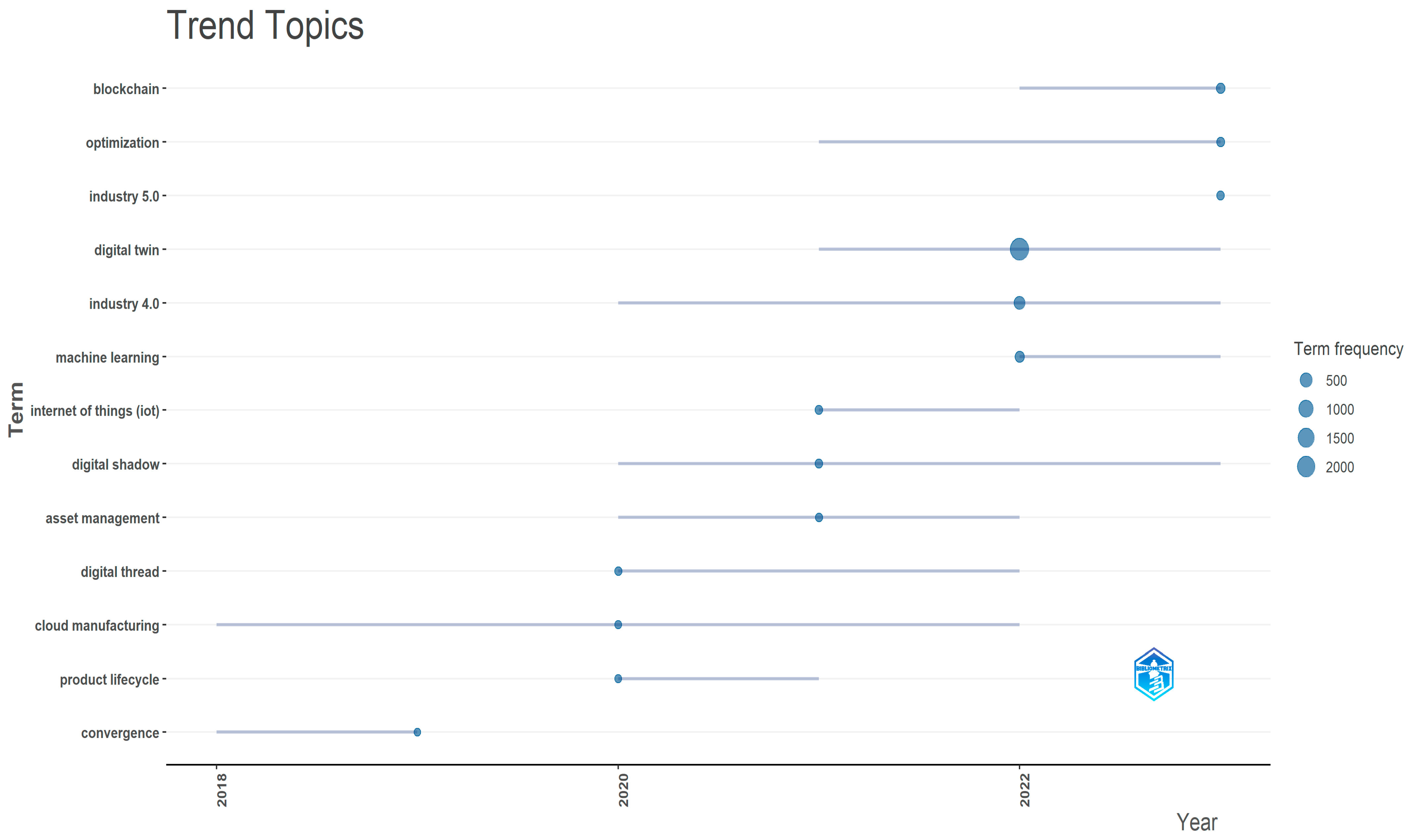
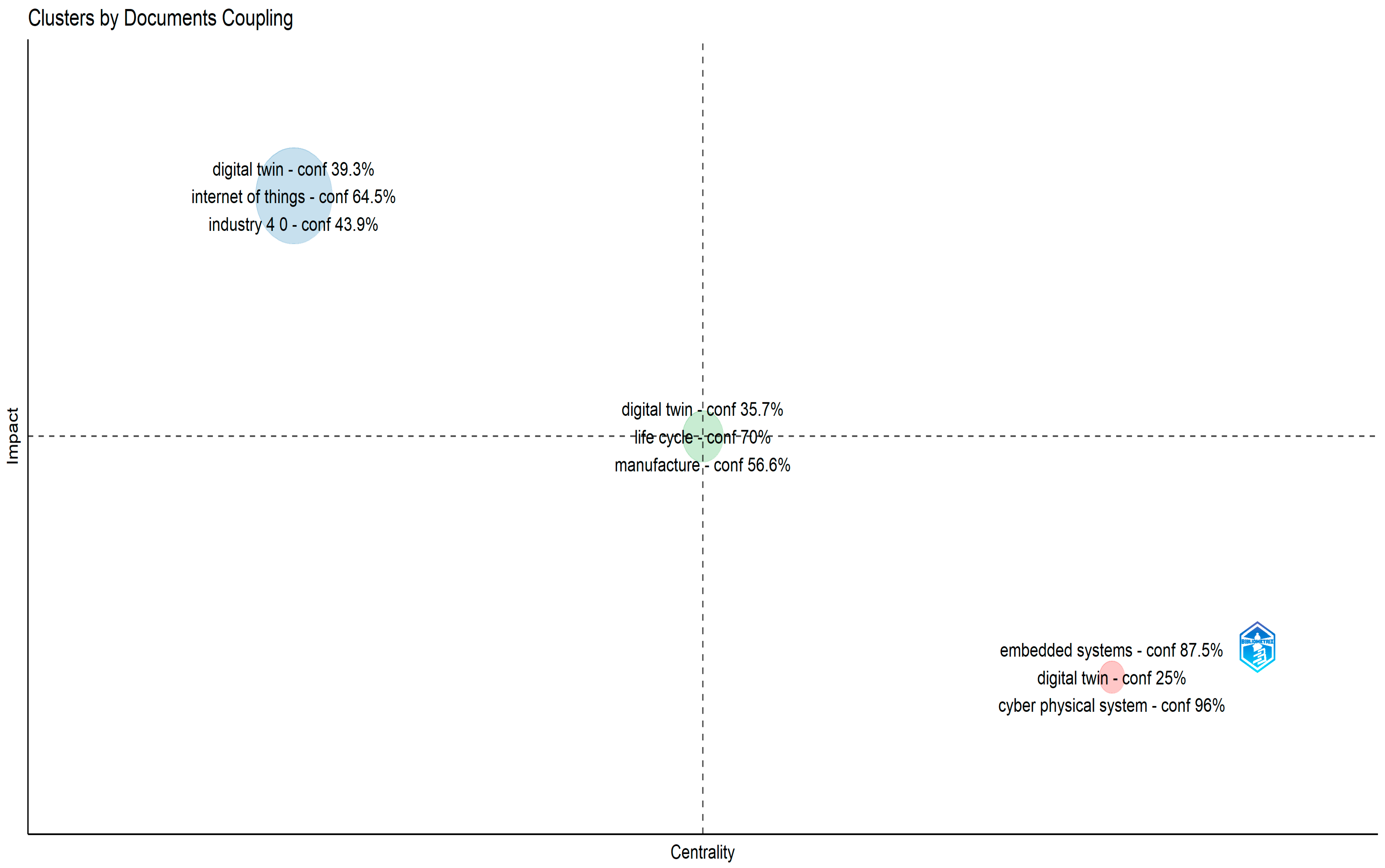

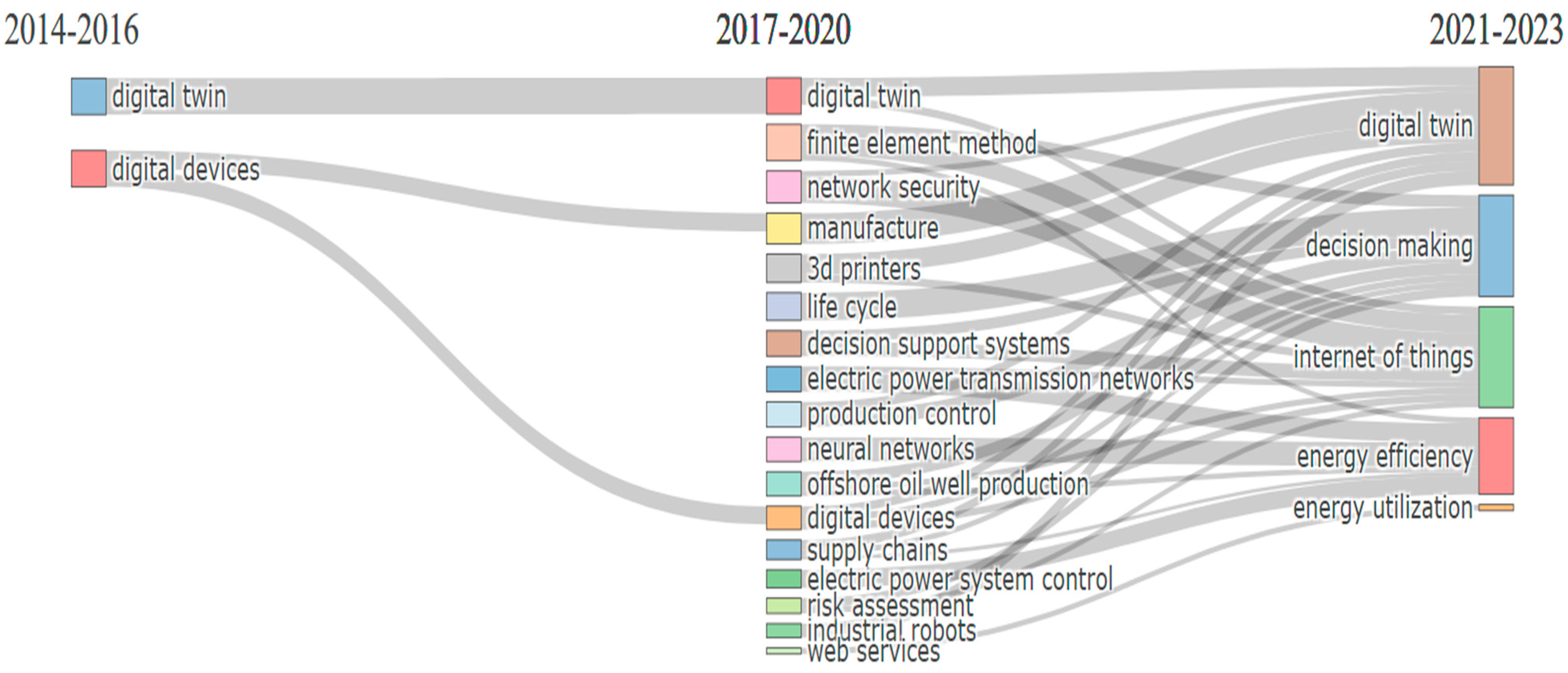
| Description | Results | Description | Results |
|---|---|---|---|
| Main information about data | Document types | ||
| Timespan | 2014:2023 | Article | 1359 |
| Sources (Journals, Books, etc.) | 1447 | Book | 11 |
| Documents | 3414 | Book chapter | 172 |
| Annual growth rate % | 35.41 | Conference/proceedings paper | 1702 |
| Document average age | 2.19 | Editorial | 27 |
| Average citations per document | 17.42 | Review | 143 |
| Document contents | Authors collaboration | ||
| Keywords plus (ID) | 14,787 | Single-authored documents | 181 |
| Author’s keywords (DE) | 6908 | Co-authors per document | 4.27 |
| Authors | International co-authorships % | 13.18 | |
| Authors | 8827 | ||
| Authors of single-authored documents | 159 |
| Year | MeanTCperArt | N | MeanTCperYear | CitableYears |
|---|---|---|---|---|
| 2014 | 103 | 1 | 9.36 | 11 |
| 2015 | 1013 | 1 | 101.3 | 10 |
| 2016 | 183.67 | 3 | 20.41 | 9 |
| 2017 | 212.93 | 14 | 26.62 | 8 |
| 2018 | 127.75 | 69 | 18.25 | 7 |
| 2019 | 66.09 | 160 | 11.02 | 6 |
| 2020 | 34.72 | 302 | 6.94 | 5 |
| 2021 | 23.7 | 555 | 5.92 | 4 |
| 2022 | 9.02 | 923 | 3.01 | 3 |
| 2023 | 2.5 | 1386 | 1.25 | 2 |
| Sources | h-Index | g-Index | m-Index | TC | NP | PY-Start |
|---|---|---|---|---|---|---|
| Journal of Manufacturing Systems | 24 | 39 | 3.429 | 2882 | 39 | 2018 |
| Procedia CIRP | 23 | 50 | 2.875 | 2567 | 75 | 2017 |
| IEEE Access | 20 | 54 | 2.5 | 3467 | 54 | 2017 |
| Applied Sciences (Switzerland) | 19 | 33 | 3.8 | 1200 | 56 | 2020 |
| IEEE Transactions on Industrial Informatics | 18 | 30 | 2.571 | 3426 | 30 | 2018 |
| International Journal of Computer Integrated Manufacturing | 15 | 26 | 2.5 | 1067 | 26 | 2019 |
| Robotics and Computer-Integrated Manufacturing | 15 | 20 | 3 | 1727 | 20 | 2020 |
| IFAC-PapersOnLine | 14 | 51 | 1.4 | 3575 | 51 | 2015 |
| International Journal of Advanced Manufacturing Technology | 14 | 26 | 2 | 2152 | 26 | 2018 |
| Procedia Manufacturing | 14 | 18 | 1.75 | 852 | 18 | 2017 |
| Source | Rank | Freq | cumFreq | Cluster |
|---|---|---|---|---|
| Procedia CIRP | 1 | 75 | 75 | Cluster 1 |
| Applied Sciences (Switzerland) | 2 | 56 | 131 | Cluster 1 |
| IEEE Access | 3 | 54 | 185 | Cluster 1 |
| IFAC-PapersOnLine | 4 | 51 | 236 | Cluster 1 |
| Sensors | 5 | 44 | 280 | Cluster 1 |
| Journal of Manufacturing Systems | 6 | 39 | 319 | Cluster 1 |
| Lecture Notes in Networks and Systems | 7 | 36 | 355 | Cluster 1 |
| Journal of Physics: Conference Series | 8 | 34 | 389 | Cluster 1 |
| IFIP Advances in Information and Communication Technology | 9 | 32 | 421 | Cluster 1 |
| Proceedings of SPIE—The International Society for Optical Engineering | 10 | 31 | 452 | Cluster 1 |
| Document | DOI | Total Citations | Total Citations per Year | Normalized Total Citations |
|---|---|---|---|---|
| [85] | 10.1109/TII.2018.2873186 | 1785 | 297.5 | 27.01 |
| [72] | 10.1007/s00170-017-0233-1 | 1752 | 250.29 | 13.71 |
| [68] | 10.1016/j.ifacol.2018.08.474 | 1550 | 221.43 | 12.13 |
| [86] | 10.1016/j.ifacol.2015.06.141 | 1013 | 101.3 | 1 |
| [87] | 10.1109/ACCESS.2018.2793265 | 986 | 140.86 | 7.72 |
| [88] | 10.1109/ACCESS.2017.2756069 | 884 | 110.5 | 4.15 |
| [89] | 10.1016/j.rcim.2019.101837 | 782 | 156.4 | 22.53 |
| [54] | 10.1016/j.jmsy.2020.06.017 | 720 | 180 | 30.38 |
| [90] | 10.1016/j.procir.2016.11.152 | 710 | 88.75 | 3.33 |
| [91] | 10.1016/j.eng.2019.01.014 | 668 | 111.33 | 10.11 |
Disclaimer/Publisher’s Note: The statements, opinions and data contained in all publications are solely those of the individual author(s) and contributor(s) and not of MDPI and/or the editor(s). MDPI and/or the editor(s) disclaim responsibility for any injury to people or property resulting from any ideas, methods, instructions or products referred to in the content. |
© 2024 by the authors. Licensee MDPI, Basel, Switzerland. This article is an open access article distributed under the terms and conditions of the Creative Commons Attribution (CC BY) license (https://creativecommons.org/licenses/by/4.0/).
Share and Cite
Lampropoulos, G.; Larrucea, X.; Colomo-Palacios, R. Digital Twins in Critical Infrastructure. Information 2024, 15, 454. https://doi.org/10.3390/info15080454
Lampropoulos G, Larrucea X, Colomo-Palacios R. Digital Twins in Critical Infrastructure. Information. 2024; 15(8):454. https://doi.org/10.3390/info15080454
Chicago/Turabian StyleLampropoulos, Georgios, Xabier Larrucea, and Ricardo Colomo-Palacios. 2024. "Digital Twins in Critical Infrastructure" Information 15, no. 8: 454. https://doi.org/10.3390/info15080454







